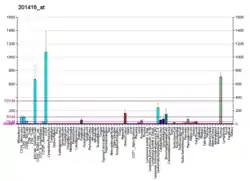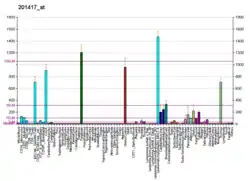SOX4
Transcription factor SOX-4 is a protein that in humans is encoded by the SOX4 gene.[5][6][7]
Function
This intronless gene encodes a member of the SOX (SRY-related HMG-box) family of transcription factors involved in the regulation of embryonic development and in the determination of the cell fate. The encoded protein may act as a transcriptional regulator after forming a protein complex with other proteins, such as syndecan binding protein (syntenin). The protein may function in the apoptosis pathway leading to cell death as well as to tumorigenesis and may mediate downstream effects of parathyroid hormone (PTH) and PTH-related protein (PTHrP) in bone development. The solution structure has been resolved for the HMG-box of a similar mouse protein.[7]
Sox4 is expressed in lymphocytes (B and T) and is required for B lymphocyte development.[8]
Clinical significance
A genomic region close to the SOX4 gene has been associated with endometrial cancer development.[9][10]
See also
References
- GRCh38: Ensembl release 89: ENSG00000124766 - Ensembl, May 2017
- GRCm38: Ensembl release 89: ENSMUSG00000076431 - Ensembl, May 2017
- "Human PubMed Reference:". National Center for Biotechnology Information, U.S. National Library of Medicine.
- "Mouse PubMed Reference:". National Center for Biotechnology Information, U.S. National Library of Medicine.
- Farr CJ, Easty DJ, Ragoussis J, Collignon J, Lovell-Badge R, Goodfellow PN (January 1994). "Characterization and mapping of the human SOX4 gene". Mammalian Genome. 4 (10): 577–84. doi:10.1007/BF00361388. PMID 8268656. S2CID 12096721.
- Critcher R, Stitson RN, Wade-Martins R, Easty DJ, Farr CJ (October 1998). "Assignment of Sox4 to mouse chromosome 13 bands A3-A5 by fluorescence in situ hybridization; refinement of the human SOX4 location to 6p22.3 and of SOX20 to chromosome 17p12.3". Cytogenetics and Cell Genetics. 81 (3–4): 294–5. doi:10.1159/000015052. PMID 9730625. S2CID 46849443.
- "Entrez Gene: SOX4 SRY (sex determining region Y)-box 4".
- Smith E, Sigvardsson M (June 2004). "The roles of transcription factors in B lymphocyte commitment, development, and transformation". Journal of Leukocyte Biology. 75 (6): 973–81. doi:10.1189/jlb.1103554. PMID 14982952. S2CID 6805071.
- O'Mara TA, Glubb DM, Amant F, Annibali D, Ashton K, Attia J, Auer PL, Beckmann MW, et al. (August 2018). "Identification of nine new susceptibility loci for endometrial cancer". Nature Communications. 9 (1): 3166. Bibcode:2018NatCo...9.3166O. doi:10.1038/s41467-018-05427-7. PMC 6085317. PMID 30093612.
- Chen MM, O'Mara TA, Thompson DJ, Painter JN, Attia J, Black A, et al. (June 2016). "GWAS meta-analysis of 16 852 women identifies new susceptibility locus for endometrial cancer". Human Molecular Genetics. 25 (12): 2612–2620. doi:10.1093/hmg/ddw092. PMC 5868213. PMID 27008869.
- Geijsen N, Uings IJ, Pals C, Armstrong J, McKinnon M, Raaijmakers JA, Lammers JW, Koenderman L, Coffer PJ (August 2001). "Cytokine-specific transcriptional regulation through an IL-5Ralpha interacting protein". Science. 293 (5532): 1136–8. doi:10.1126/science.1059157. PMID 11498591. S2CID 28003281.
Further reading
- Kamachi Y, Uchikawa M, Kondoh H (April 2000). "Pairing SOX off: with partners in the regulation of embryonic development". Trends in Genetics. 16 (4): 182–7. doi:10.1016/S0168-9525(99)01955-1. PMID 10729834.
- Bowles J, Schepers G, Koopman P (November 2000). "Phylogeny of the SOX family of developmental transcription factors based on sequence and structural indicators". Developmental Biology. 227 (2): 239–55. doi:10.1006/dbio.2000.9883. PMID 11071752.
- Wilson M, Koopman P (August 2002). "Matching SOX: partner proteins and co-factors of the SOX family of transcriptional regulators". Current Opinion in Genetics & Development. 12 (4): 441–6. doi:10.1016/S0959-437X(02)00323-4. PMID 12100890.
- Schepers GE, Teasdale RD, Koopman P (August 2002). "Twenty pairs of sox: extent, homology, and nomenclature of the mouse and human sox transcription factor gene families". Developmental Cell. 3 (2): 167–70. doi:10.1016/S1534-5807(02)00223-X. PMID 12194848.
- Denny P, Swift S, Brand N, Dabhade N, Barton P, Ashworth A (June 1992). "A conserved family of genes related to the testis determining gene, SRY". Nucleic Acids Research. 20 (11): 2887. doi:10.1093/nar/20.11.2887. PMC 336939. PMID 1614875.
- Wotton D, Lake RA, Farr CJ, Owen MJ (March 1995). "The high mobility group transcription factor, SOX4, transactivates the human CD2 enhancer". The Journal of Biological Chemistry. 270 (13): 7515–22. doi:10.1074/jbc.270.13.7515. PMID 7706298.
- van de Wetering M, Oosterwegel M, van Norren K, Clevers H (October 1993). "Sox-4, an Sry-like HMG box protein, is a transcriptional activator in lymphocytes". The EMBO Journal. 12 (10): 3847–54. doi:10.1002/j.1460-2075.1993.tb06063.x. PMC 413668. PMID 8404853.
- van Houte LP, Chuprina VP, van der Wetering M, Boelens R, Kaptein R, Clevers H (December 1995). "Solution structure of the sequence-specific HMG box of the lymphocyte transcriptional activator Sox-4". The Journal of Biological Chemistry. 270 (51): 30516–24. doi:10.1074/jbc.270.51.30516. PMID 8530483.
- Ahn SG, Cho GH, Jeong SY, Rhim H, Choi JY, Kim IK (June 1999). "Identification of cDNAs for Sox-4, an HMG-Box protein, and a novel human homolog of yeast splicing factor SSF-1 differentially regulated during apoptosis induced by prostaglandin A2/delta12-PGJ2 in Hep3B cells". Biochemical and Biophysical Research Communications. 260 (1): 216–21. doi:10.1006/bbrc.1999.0856. PMID 10381369.
- van Beest M, Dooijes D, van De Wetering M, Kjaerulff S, Bonvin A, Nielsen O, Clevers H (September 2000). "Sequence-specific high mobility group box factors recognize 10-12-base pair minor groove motifs". The Journal of Biological Chemistry. 275 (35): 27266–73. doi:10.1074/jbc.M004102200. PMID 10867006.
- Reppe S, Rian E, Jemtland R, Olstad OK, Gautvik VT, Gautvik KM (December 2000). "Sox-4 messenger RNA is expressed in the embryonic growth plate and regulated via the parathyroid hormone/parathyroid hormone-related protein receptor in osteoblast-like cells". Journal of Bone and Mineral Research. 15 (12): 2402–12. doi:10.1359/jbmr.2000.15.12.2402. PMID 11127205. S2CID 2013715.
- Geijsen N, Uings IJ, Pals C, Armstrong J, McKinnon M, Raaijmakers JA, Lammers JW, Koenderman L, Coffer PJ (August 2001). "Cytokine-specific transcriptional regulation through an IL-5Ralpha interacting protein". Science. 293 (5532): 1136–8. doi:10.1126/science.1059157. PMID 11498591. S2CID 28003281.
- Lee CJ, Appleby VJ, Orme AT, Chan WI, Scotting PJ (May 2002). "Differential expression of SOX4 and SOX11 in medulloblastoma". Journal of Neuro-Oncology. 57 (3): 201–14. doi:10.1023/A:1015773818302. PMID 12125983. S2CID 20719302.
- Ahn SG, Kim HS, Jeong SW, Kim BE, Rhim H, Shim JY, Kim JW, Lee JH, Kim IK (July 2002). "Sox-4 is a positive regulator of Hep3B and HepG2 cells' apoptosis induced by prostaglandin (PG)A(2) and delta(12)-PGJ(2)". Experimental & Molecular Medicine. 34 (3): 243–9. doi:10.1038/emm.2002.34. PMID 12216117.
External links
- SOX4+protein,+human at the US National Library of Medicine Medical Subject Headings (MeSH)
This article incorporates text from the United States National Library of Medicine, which is in the public domain.






